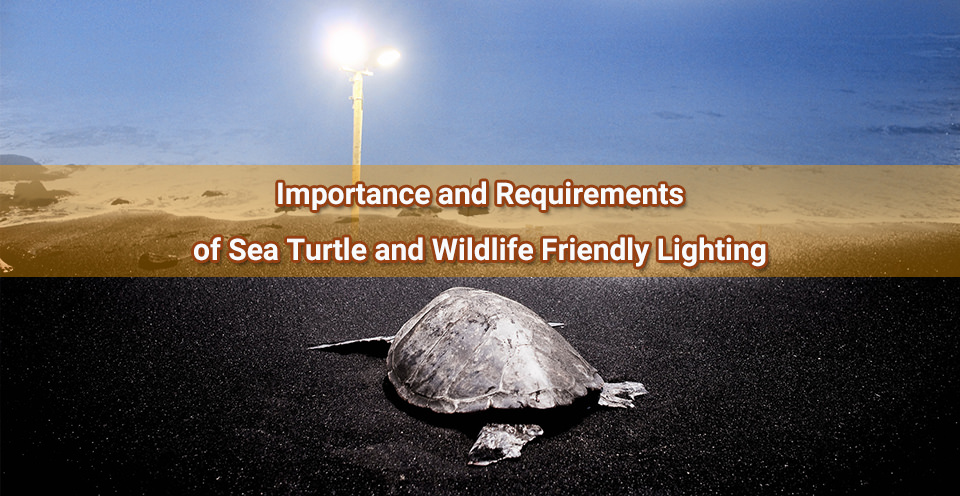
Have you ever noticed the red or amber light in coastal areas? This light is different from the white light that normally appears in other applications. Well, the red or amber light is typically designed to protect wildlife, such as sea turtles and birds, from lighting trespass.
With the development of artificial light, humans can enjoy the beautiful scenery and relax at night in coastal areas. The adoption of artificial lighting not only brights the life at night, but also significantly disorders the circadian rhythms of wildlife. Sea turtles cannot find their way to the sea and nesting beach because of the shining artificial light. Birds are suffered from the glare of artificial light. They become confused and get lost during migration.
To protect the vulnerable wildlife in coastal areas, some called ‘wildlife friendly lighting’ was announced. Since there are tremendous wildlife species and each of them has different requirements, we take the sea turtle as an example to show you the guide to sea turtle-friendly lighting in this post.
Why should we use sea turtle-friendly lighting
Sea turtle-friendly lighting is of long wavelength, low lumen output, and shielded light. It can avoid and minimize the negative impact on sea turtles. The reasons for using sea turtle-friendly lighting are mainly to prevent detrimental effects on sea turtles. But except for ecological benefits, people who adopted the turtle-friendly lighting found it also had a remarkable decrease in their electricity bills.
Sea turtle-friendly lighting defends the chances of survival of sea turtles
Sea turtles are nocturnal animals, and they are active at night. They are also sensitive to the light lower than 580 nm. Adult sea turtles prefer a dark environment. Therefore, female sea turtles come to shore and nest in darker areas on the beach at night. Then, they will back to the sea after nesting. But the bright and short wavelength artificial light alters the normal behavior of adult sea turtles from natural light. Sea turtles are not sure when and where they should nest. As a result, nest densities, which are important for the population, are reduced. Artificial light also misleads their way to the ocean.
Just imagine that the sea turtles are anxious to trace the way back to the sea on a fully illuminated beach. At last, sea turtles will be exhausted or even die under the artificial light. What makes it even worse is that artificial light can increase hatchling mortality. Hatchlings will emerge from their nests at night. Similarly, they will lose their way to the sea and dehydrate due to the interference of artificial light. In contrast, sea turtle-friendly lighting will not disturb the normal behaviors of sea turtles. Thus, sea turtle-friendly lighting defends changes of survival of sea turtles.
Sea turtle-friendly lighting helps to cut down electricity bills
Since sea turtle-friendly lighting utilizes less quantity and lower wattage lighting fixtures, it enables a significant decrease in electricity bills. People who retrofit the traditional lighting fixtures to more energy-efficient and sea turtle-friendly LED lights benefited a nearly 70% outside electricity bill savings. Although the initial cost for lighting retrofit could be expensive, the average cost over time will be balanced and reduced. As a consequence, using sea turtle-friendly lighting can help you save the cost.
Requirements of sea turtle-friendly lighting
Golden rules
The basic requirement of sea turtle-friendly lighting is to avoid and minimize the negative effects on sea turtles. FWC (Florida Fish and Wildlife Conservation Commission) institutes three golden rules, keep it low, keep it shielded, and keep it long. These rules are applicable for installing or modifying lights and protecting wildlife in marine areas.
Keep it low:
Lighting fixtures must be installed at the lowest mounted height and produce the lowest lumens to meet the basic needs.
Keep it shielded:
Lighting fixtures must be downward-directed and shielded from the beach.
Keep it long:
Lighting fixtures must produce only long wavelength (greater than 560nm) light.
Indoor lighting requirements
It seems that indoor lighting is far away from the beach. And the interior light is not likely to be visible from the beach. But the light is in fact, visible to sea turtles. Thus, all indoor lights that might be visible to sea turtles must be minimized, including the light moving through windows and doors, as well as the light emitted by televisions. Residents living in the coastal areas are required to shade the windows with curtains, or even turn off the lights and TV in the period of turtle nesting.
Outdoor lighting requirement
Outdoor lighting must be adhered to a basic requirement, fully shielded. Other requirements of outdoor lighting include long wavelength, low wattage, and minimum amount. Apart from the three golden rules, here are some details about the lighting requirements in outdoor applications:
- All outdoor lights are not allowed to illuminate the beach in any way (direct, indirect, or cumulative), nor visible to the people standing on the beach.
- There shall not be reflective surface around lighting fixtures.
- Pond and fountain lights are not allowed to be placed on the seaward or shore-perpendicular sides of any structures.
- They are not allowed to illuminate the beach in any way, nor visible to the people standing on the beach.
- Parking lot and roadway lights shall not emit more than 1.0 footcandles (average) of light in any place.
- Pole-mounted way can only be used in parking lots and roadways when the lights mounted at a lower height cannot meet the minimum level for safety.
- The light source of bollard lights shall be fully hidden and shielded. The height of bollard lights shall not exceed 42 inches above the deck or floor.
Want to know how to achieve sea turtle and wildlife-friendly lighting?
We will show you the guide to sea turtle and wildlife lighting in the next post.
Stay tuned!
Related video:












